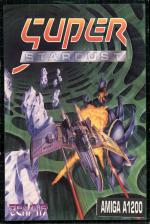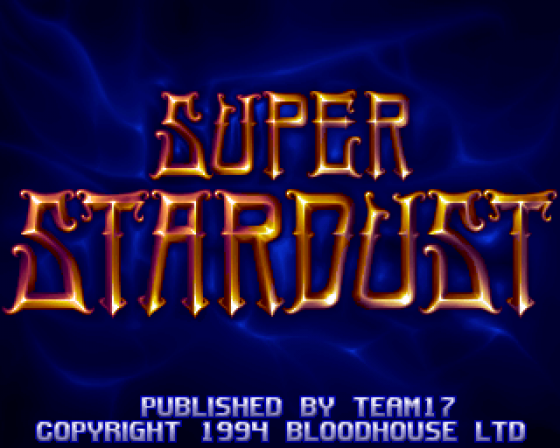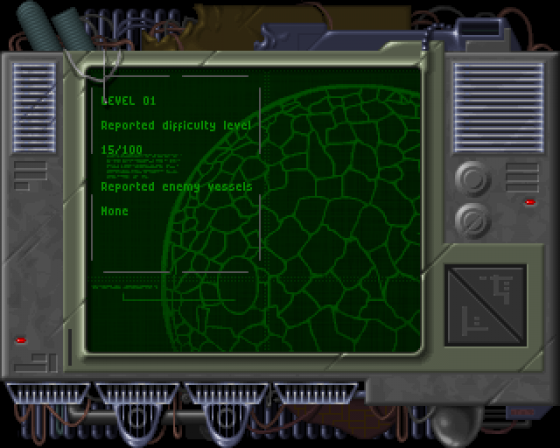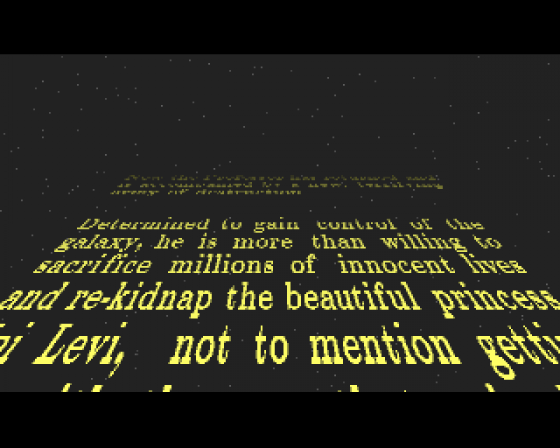
Amiga Power
 1st October 1994
1st October 1994
Categories: Review: Software
Author: Jonathan Nash
Publisher: Team 17
Machine: Amiga 1200
Published in Amiga Power #42
Super Stardust
Soft. That's the word for Super Stardust. Not only has the astoundingly high difficulty level of the famously non-selling A500 version been wound down a crank or two, but the graphics have been given a plumper, smoother look and the music (and even the explosions) a warmer, rounder sound to create an altogether 'softer' feel.
No, it's no good.
*What's wrong with you people*? We told you that D/Generation was terrific. We told you it was astonishingly cheap, and you ignored us. Then we told you that Stardust was terrfic, and it was even more shockingly inexpensive, and that if you didn't buy it for being fabulous and not-at-all pricey after complaining about rockering game costs then you were all oikish hypocrites and deserved the inevitable price hikes when the programmers quite sensibly licensed their game to a software house rather than relying on your goodwill and selling it mail order, and again you ignored us. And now Bloodhouse have done just that and it's going to cost you more to buy Super Stardust and, indeed, Stardust which is being re-released, and you know what? You're all going to buy it now, because you've got some stupid preconceptions that because a game is cheap it has to be poor, and that having it taken up by an established company and given a big box and some advertising somehow makes it better, and you're going to feel so much happier about paying more for it in some High Street shop rather than buying it directly from the people who did all the work and may you soon be as financially bankrupt as you are morally, you unbelievably stupid whingers.
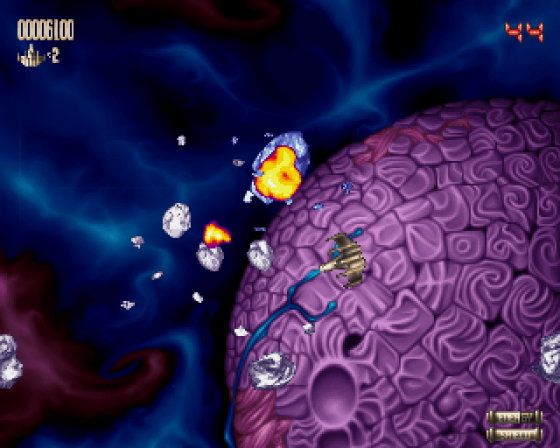
That's better.
Finished
Well, um, here I am with four pages to write about what is, essentially, Asteroids with a 3D section. Looking back at the review of the original game cunningly exhausted all possible topics (describing the aim of the game and its merits and drawbacks [Fiendishly cunning, yes - Ed], outlining the ingenious power-up system, er, shouting about people not buying the game) leaving me in a right old pickle. Crumbs.
And you're probably all just interested in looking at the pictures anyway.
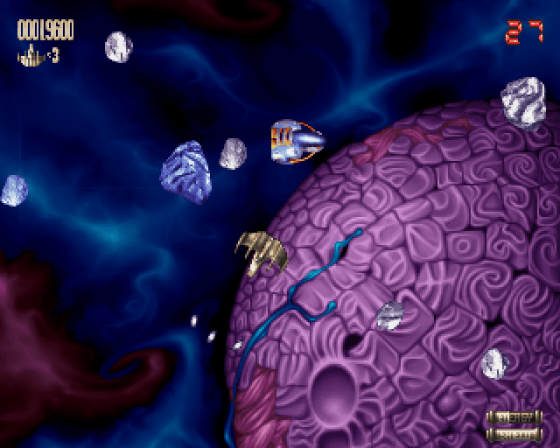
Actually, there's one thing I could say. In the review, Stuart complained about the lack of keyboard control. It was, he said, a fatal error considering the amount of pixel-perfect manoeuvring required. Well, such is the influence that Amiga Power commands, Bloodhouse have fixed things for Super Stardust. There are, in fact, two keyboard options, to do with the positioning of the thrust and fire keys or something (I'm unswayably inclined towards the office fire-buttons-replacing-up-and-down joypad actually), so all hail to Amiga Power! Um.
I suppose... I suppose I could talk about the basics of the game, because, technically, it's not quite Asteroids. That venerable game, as you will no doubt recall, being fans of old coin-ops and not, for example, dynamic young people living for the here and now, had you shooting at big rocks, which split into smaller rocks, then tiny rocks which finally exploded. In Super Stardust, there are different strengths of rock. The ordinary grey rocks (except they're more sort of ruggedly silver. Look at that raytracing! But that's talking about the graphics, which has been done, Jimmy) for example take but a few hits to demolish, whereas the mauve boulders are substantially harder than the intermediate blue ones. (Gold boulders are very bad news.) In fact, not only do the rocks vary in resilience, the different chapters move at different speeds, so rather than having a predictable Asteroids screen where you know that the titchy boulders will zoom around faster than the big ones, the game litters the playing area with tricky blighters that tend to take you by surprise.
Actually, taking you by surprise is a speciality of Super Stardust. Quite apart from the difficulties of playing a game where using the screen wraparound is of tremendous importance (and it's a breakthrough moment when you stop frantically trying to stay in the centre of the screen where, fairly obviously, the concentration of boulders is at its highest and work with the wrap to speed out of danger and pounce on something from behind) the introduction of monsters with the second level causes near-panic.
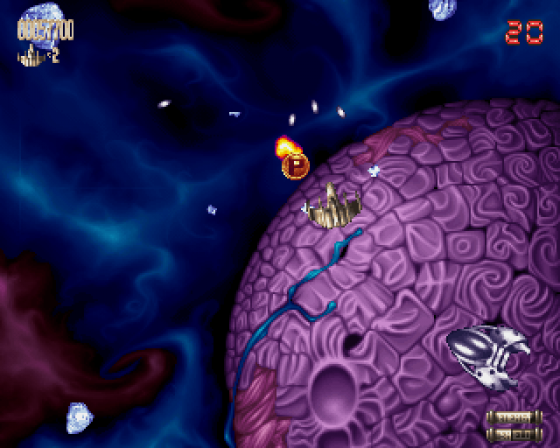
There monsters - unlike the feeble bleep of the original game, heralded with a piercing, jangling alarm klaxon - try their damnedest to do away with you in so many nasty ways, the very least of which is following you doggedly around the screen. (The very most involves something remarkably unpleasant to do with overwhelming odds, spnning spiked arms that overlap the screen edges so you're in danger from three directions at once, and leisurely bombers spilling proximity mines.) It makes each new screen an adventure, with you whittling away at the rocks then being expertly frightened by the klaxons, flitting around the screen nervously trying to anticipate where the monsters will appear, and then getting taken by surprise. I do like that in a game.
Sixty
The tunnels then. The bits where you get from one level to another after defeating the big monster, except that's like calling ["Standing atop the Blacktool Tower in a high wind with a big flappy coat" and not, for example, anything to do with the Big One - Legal Ed] reasonably invigorating. You really can't appreciate the devastating majesty of these sections until you're there, bobbing in your seat to the jinks of your ship and screaming in emphathic fear as it detonates against a razor-edged wheel the size of Peru. Again, the programmers have shamelessly looted an old coin-op (the sticking your head out of the window of a car going 60mph-rushingly 3D Space Harrier, to be exact) but have trampled all over it in terms of speed, impact and nerve-zapping gameplay. The rogues.
Percent
There is, however, one thing wrong with Super Stardust. One quite big thing, actually. It really is 'soft'. After the terrifying challenge of Stardust, you'd expect Team 17 to impose a 'friendlier' level of difficulty on the game (as they did with the re-release of Project-X). But, oddly, they've gone almost to the other extreme. You can be blasting away, marvelling at the presentation, goggling at the horrendous destructive powewr of your guns as rocks splinter all around, sweeping around to catch out the monsters, tackling the power-up-laden sub-levels early on to charge up your guns ever more and endangering your thumb in the tunnels, when suddenly you realise you've just completed level three and there are only five altogether. And there are passwords.
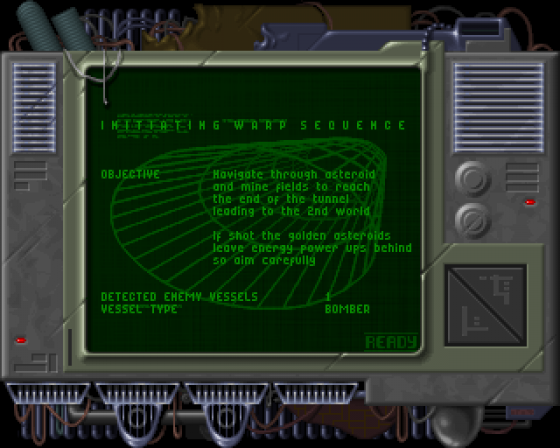
It's not necessarily a bad thing (Stardust just tended to make you angry on the later levels with its absurd over-aggressiveness) but the almost supernatural ease with which everybody who played the game sailed through it smacks slightly of compromise. And compromise is, of course, a tool of the devil.
Only
But you'll probably not be interested in our reactionary mumblings. You'll be justifiably excited about the game's engulfing playability, constant variety, truly cinematic moments (the bit where this gigantic rock - and we're talking ship-dwarfing - rolls in from one corner, and you speed off to avoid it, and another gargantuan boulder tumbles out from the opposite corner and the two squash you in between demands to be shown on a big screen to a breathless audience), bizarre percentages (such as shot-to-hit ratios and, er, power-up icons missed) and frankly astonishing presentation. Good for you.
The Bottom Line
Uppers: Spectacular, that's the word for Super Stardust. And elegant. Playable, that's another one. And thumpingly exciting. (But that's two.)
Downers: Vastly easier than the original - you should have no trouble getting to, say, level three on the first day. The engine power-up's annoying as well - it just increases your speed, which scuppers your turning circle.
The mechanics have been tidied up since Stardust, and it obviously trounces the original on presentation. But I'm genuinely perturbed by the lazy ease with which I sailed through 60% of the game. Hmmm. It is a great game, there's no denying that, and I have little doubt that I shall be returning for another prolonged crack at it in a couple of weeks. So... subtract this, add that... Yes. All things considered, I'd say the original mark stands.

